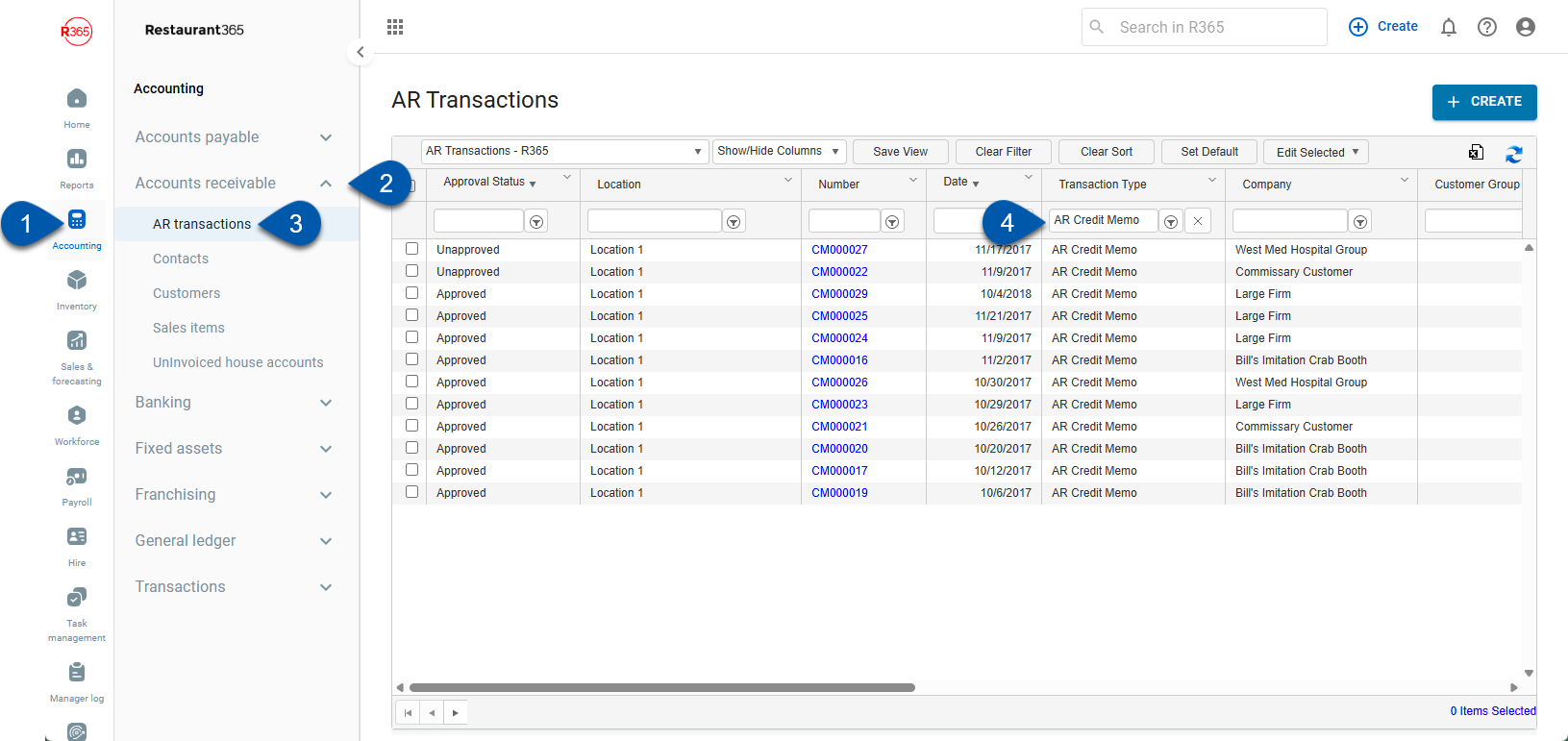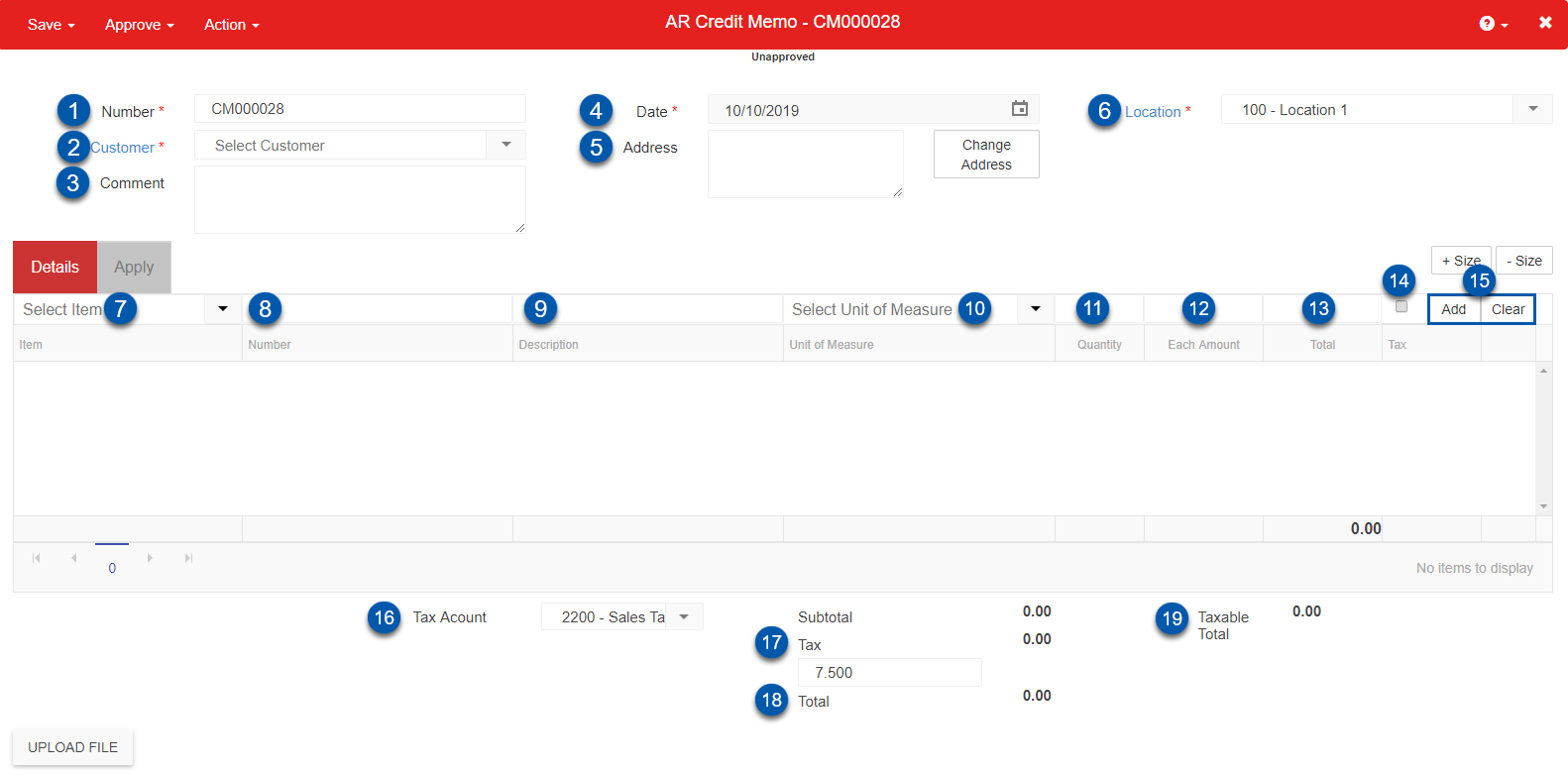The AR Credit Memo is part of Accounts Receivable within the Accounting module of Restaurant365. They are generally used to apply to AR Invoices (cancel out the invoice) by issuing a Credit to a Customer.
Navigation
Create a new credit memo:
Click create in the top ribbon, then select Credit Memo.

View an existing credit memo:
Open the Accounting application.
Click Accounts Receivable to expand the folder.
Click AR Transactions.
Search AR Credit memo in the Transaction Type column or scroll to find the desired credit memo.

Security
The permissions listed here are associated with AR Credit Memos. These Permissions can be added to Custom User Roles or single Users. Learn more about managing Permissions and Custom User Roles here.
AR Credit Memo Permissions are found in the Permission Tree as follows:
Accounts Receivable
AR Credit Memos
View AR Credit Memos
Edit AR Credit Memos
Create AR Credit Memos
Approve AR Credit Memos
Unapprove AR Credit Memos
Void AR Credit Memos
Unvoid AR Credit Memos
Delete AR Credit Memos
The Permission Access report can be used to determine which User Roles or Users already have these Permissions assigned.
Learn more about User Setup and Security here.
AR Credit Memo
Number - The number associated with the Credit Memo. This number will be auto-generated and can be modified on the Autonumbering page
Customer - The name of the Customer receiving the Credit Memo
Comment - An optional field to include notes about the Credit Memo
Date - The date this Credit Memo was created. This is auto-populated with the date this form was opened
Address - The address of the Customer. This will be auto-populated with the address noted on the Customer record, but it can be changed manually by clicking the 'Change Address' button next to this field
Location - The Location processing the Credit Memo. This will be set to the User's default Location but can be manually changed
Locations will be grayed out if they are inactivated. Click here to learn how to inactivate a Location
Item - The item you want to credit
Number - The Item Number from the item record selected. This is read-only
Description - The default description of the item from the Item record. This field, however, can be edited
Unit of Measure - The Sales U of M on the Item record. This field, however can be edited
Quantity - The Quantity of the item being credited
Each Amount - The Price on the 'Sales' tab of the Item record. This is auto-populated but can be edited
Total - The calculation of 'Quantity' multiplied by 'Each Amount'
Tax checkbox - Check this box if that row is taxable and that amount will be added to the Taxable Total for this transaction
Add / Clear Button - Click 'Add' to include the line information into the grid below or click 'Clear' to clear out the information entered into the row
If an item needs to be deleted after adding it into the grid, click the trash can icon at the end of the line item's row
Tax Account - If there is a tax amount on the transaction, a GL entry will be added to the 'Distribution' tab upon saving for that amount, and the GL account will be this tax account. This defaults from System Preferences but can be edited
Tax Percent - The tax percent as noted on the Location record but can be edited.
Total - The tax amount is calculated as the 'Taxable Total' multiplied by the 'Tax Percent'
Taxable Total - The sum of all detail rows where the Taxable check box is checked
When finished, click either 'Save' or 'Approve' the transaction.
Edit an Approved AR Credit Memo
Users with the 'Approve AR Credit Memos' Permission will have the ability to edit an Approved Credit Memo without the need to Unapprove first.

To do so, click the Edit button above the Details grid, make any necessary updates, and then click Edit Complete to save the changes made.
Apply an AR Credit Memo

If there's an invoice this credit should be applied to, navigate to the 'Apply' tab and click the 'Apply' checkbox next to the necessary invoice(s).
The Apply Date must be the most recent date listed on the AR Invoice form (either the Invoice Date or the Payment/Credit Memo Date) and will be automatically updated to that date when checked. In the example above, the AR Invoice that was selected had an original date of 10/2/2019, but since the date of the AR Credit Memo was 2/22/2020, the 'Apply Date' automatically updated to the most recent date listed, which was 2/22/2020.
This date can be in a closed period if a journal entry is not created due to a discount or an intercompany entry being made. The fiscal period status is examined for the Location on the header of the AR Invoice and the header of the Payment and/or Credit Memo. If one of the dates is in a closed period, an error message for the closed fiscal period will be displayed.
An intercompany entry will be listed when a Payment or Credit Memo is applied to an invoice from a different legal entity.
Once checked, 'Save and Close' the AR Credit Memo to complete the process.
If you have applied transactions to this Credit Memo in the 'Apply' tab, then you must Approve instead of just saving. Clicking 'Approve' will both Save and Approve the transaction at the same time.
Unchecking the Apply Checkbox
Unapplying the Apply Checkbox can be done easily after Unapproving the AR Credit Memo by simply re-clicking the Apply checkbox next to the currently selected payment. However, should a Journal Entry be created due to the reversal of a discount or intercompany entry, the date listed will be pulled from the below dates in the following order:
The Apply Date if in an open period
If the Apply Date is in a closed period, then a prompt will appearand will suggest the next available date that is in an open period to select, which will either be:
Legal Entity Close Date - The date of the most recent closed period + 1 day from either the AR Invoice Location's Legal Entity record or the AR Payment/Credit Memo Location's Legal Entity record
Advanced Close Date- The most recent open period date after the the most recent date listed on either the AR Invoice's Location or the AR Payment/Credit Memo's Location
If a date is selected in a closed period, you will be unable to save the resulting Journal Entry.
